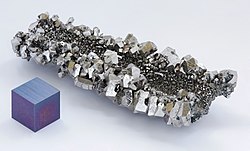Niobium
Niobium has physical and chemical properties similar to those of the element tantalum, and the two are therefore difficult to distinguish. The English chemist Charles Hatchett reported a new element similar to tantalum in 1801 and named it columbium. In 1809, the English chemist William Hyde Wollaston wrongly concluded that tantalum and columbium were identical. The German chemist Heinrich Rose determined in 1846 that tantalum ores contain a second element, which he named niobium. In 1864 and 1865, a series of scientific findings clarified that niobium and columbium were the same element (as distinguished from tantalum), and for a century both names were used interchangeably. Niobium was officially adopted as the name of the element in 1949.
It was not until the early 20th century that niobium was first used commercially. Brazil is the leading producer of niobium and ferroniobium, an alloy of niobium and iron. Niobium is used mostly in alloys, the largest part in special steel such as that used in gas pipelines. Although alloys contain only a maximum of 0.1%, that small percentage of niobium improves the strength of the steel. The temperature stability of niobium-containing superalloys is important for its use in jet and rocket engines. Niobium is used in various superconducting materials. These superconducting alloys, also containing titanium and tin, are widely used in the superconducting magnets of MRI scanners. Other applications of niobium include its use in welding, nuclear industries, electronics, optics, numismatics and jewelry. In the last two applications, niobium's low toxicity and ability to be colored by anodization are particular advantages.
Occurrence
Niobium is estimated to be the 33rd most common element in the Earth’s crust, with 20 ppm. Some think that the abundance on Earth should be much greater, but that the "missing" niobium may be located in the Earth’s core due to the metal's high density. The free element is not found in nature, but it does occur in minerals. Minerals that contain niobium often also contain tantalum, such as columbite ((Fe,Mn)(Nb,Ta)2O6) and columbite–tantalite (or coltan, (Fe,Mn)(Ta,Nb)2O6). Columbite–tantalite minerals are most usually found as accessory minerals in pegmatite intrusions, and in alkaline intrusive rocks. Less common are the niobates of calcium, uranium, thorium and the rare earth elements such as pyrochlore ((Na,Ca)2Nb2O6(OH,F)) and euxenite ((Y,Ca,Ce,U,Th)(Nb,Ta,Ti)2O6). These large deposits of niobium have been found associated with carbonatites (carbonate-silicate igneous rocks) and as a constituent of pyrochlore.
The two largest deposits of pyrochlore were found in the 1950s in Brazil and Canada, and both countries are still the major producers of niobium mineral concentrates. The largest deposit is hosted within a carbonatite intrusion at Araxá, Minas Gerais Brazil, owned by CBMM (Companhia Brasileira de Metalurgia e Mineração); the other deposit is located in Goiás and owned by Anglo American plc (through its subsidiary Mineração Catalão), also hosted within a carbonatite intrusion. Altogether these two Brazilian mines produce around 75% of world supply. The third largest producer of niobium is the carbonatite-hosted Niobec Mine, Saint-Honoré near Chicoutimi, Quebec owned by Iamgold Corporation Ltd, which produces around 7% of world supply.
| Symbol | Nb | |
| Atomic Number | 41 | |
| Atomic Weight | 92.90638 | |
| Oxidation States | +3,+5 | |
| Electronegativity, Pauling | 1.6 | |
| State at RT | Solid, Metal | |
| Melting Point, K | 2741 | |
| Boiling Point, K | 5015 |
Appearance and Characteristics
Harmful effects:
Some niobium compounds are highly toxic.
Characteristics:
- Niobium is a shiny, white, ductile metal. In air an oxide layer forms whose color depends on its thickness. Shades of blue, green and yellow are typical.
- Niobium resists corrosion due to the oxide film. The metal starts to oxidize rapidly in air at 200 oC.
- Niobium’s chemical properties are very similar to those of tantalum.
- Niobium is one of the five major refractory metals (metals with very high resistance to heat and wear). The other refractory metals are tungsten, molybdenum, tantalum and rhenium.
Uses of Niobium
- Niobium is used with iron and other elements in stainless steel alloys and also in alloys with a variety of nonferrous metals, such as zirconium,
- Niobium alloys are strong and are often used in pipeline construction.
- The metal is used in superalloys for jet engines and heat resistant equipment.
- Niobium is also used for jewelry. At cryogenic temperatures, niobium is a superconductor.
